Native Son: Albany and Abilene
I got an invite to come out to Abilene, eat a rib eye, visit a few gardens, see an old friend, meet some new ones, and talk about “Texas Tough Plants.” Truth be told, they had me at “rib eye”….
So I’m just cruisin’ west on Highway 180, counting landmarks as they go by … awesome road cut just before Clark Gardens, the eerie yet beautiful Baker Hotel, the quirky little castle house, a lazy elbow in the Brazos River, that gas pump in Palo Pinto that hasn’t worked in decades (but they always seem to be working on it), the two-toned charcoal and gray landscape of dead trees that succumbed to fire and drought, a roadrunner on the shadows of Beaver Mountain, that urban grove of (ouch!) topped pecan trees, the struggling Hubbard Creek Reservoir … when I realize this land tells a story, many stories, if I am willing to crack the hardback covers of my mind and read them. Some of these stories are of foolishness, some of folly, but what I see before me are tales of perseverance and adaptation and, as k d lang put it, “the beautiful struggle” that is life itself.
I mindlessly check the speedometer and fuel gauge, and all seems okay, but I also notice my blood pressure has dropped about 30 points. Somewhere back a-ways, a rope musta broke, because I lost my load of anxieties. Too late to turn back now….
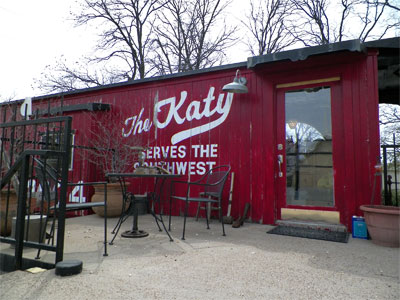
Railroad car converted to beauty salon in Albany, Texas. Photos by Steven Chamblee.
I roll into the tiny town of Albany and, suddenly, I feel different. I mean physically different, like my body is intuitively sensing something almost palpable in the air here, like I drove into a cloud of childhood happiness. Everything’s clean, people are smiling, a cat naps atop a snoozing dog. Over there, a couple of railroad freight cars are converted into … an alternative office, a groovalicious abode? Interesting. Two blocks later, I decide I have just got to find out, so I hook a right off into a sleepy little neighborhood. Wow … old stone houses. Lots of old stone houses. Not pretentious mansions, just well-crafted homes. (My memory quickly takes me to the old silver mining towns of Mexico, where many fine stone houses still stand, proud testament to the influx of money long ago.) I surmise there was once an age of prosperity here as well. Maybe there still is … oil, cattle…? I decide the answer is at the railroad cars.
I knock on the door just as a woman inside comes to it, and we scare each other half to death. A few deep breaths later, she waves me in and apologizes for the heavy scent of burnt popcorn in the air. I commiserate, noting it only takes about 20 seconds to go from people-pleasing perfect to charred chicken chow. (Actually, my chickens are so spoiled that they won’t eat it.) I look around; it’s a beauty shop! I laugh out loud with delight as I tell her that I just love this place. We chat as she curls hair and my eyes feast upon the charming bric-à-brac that fills the interior, most notably the collection of memorabilia about England’s Royal Family. I casually drop my curiosity on the table … “Why is Albany so different than the other small towns around here?” She tells me the love of the people here makes this place what it is. Folks here unselfishly invest their time and money into the town simply because it’s the right thing to do. By investing in the quality of their town, they have created an amazing community not only for themselves, but for future generations as well. I stand there and smile. I think this is the kind of America our forefathers dreamt of, and it didn’t just happen by itself. It takes good hearts, hard-workin’ hands, and a bucketful of gumption. (Is that John Phillip Sousa floating on the wind?) I thank her and head out, quick-stopping at the Chamber of Commerce, located in the old train depot. I also take a moment to admire the restored Sinclair Station, which looks as beautiful as she did when she first opened in 1935.
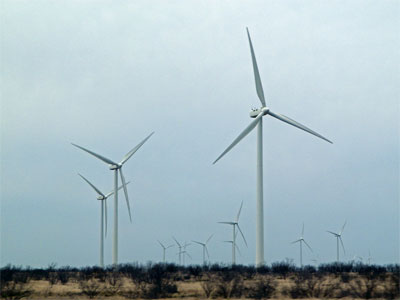
Modern windmills have replaced oil derricks north of Abilene.
While I agree that Fort Worth is “Where the West Begins,” Abilene is, to me anyway, where “West Texas Begins.” High-tech windmills have replaced oil derricks out here north of town, pumping out clean energy amidst a sea of ubiquitous mesquite trees. It seems funny to me how Texans in general have become grousy concerning these amazing trees (indestructible; good honey; fine lumber; perfect shade; and every BBQ-er’s best friend), but then again, I’ve never had to live on 500 acres of them, either.
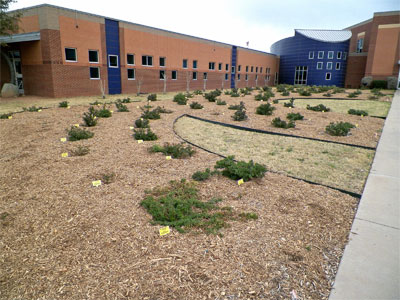
The fledgling dwarf rose trial garden at Cisco College.
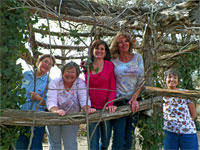
The host committee: (left to right) Joyce Jay, Vicki Adams, Rhonda Blanton, Kathy Feagan, Carol Blessing
I finally slide into Abilene about 3 p.m., and quickly find out there is a small army of people anxiously awaiting my arrival, so they can treat me to lunch. (Whoops!) Fortunately, they are gracious and quick to forgive, so we head to the steak house for that legendary “Abilenian Rib Eye.” Foreshadowing the afternoon, the reality of the steak is actually better than the anticipation. Stuffed and puffed, we cruise over to Cisco College to check out the Big Country Master Gardeners’ latest and greatest double project: a National EarthKind dwarf rose trial and a National EarthKind perennial plant trial done in conjunction with Texas A&M Agri-Life Extension. Huge swirling beds adorn the front of the campus, chock full of just-planted beauties just waiting for time and temperature to rocket them into their full, colorful potential. There we are, standing in front of what many folks would perceive as a bunch of mulch on the ground, envisioning the future. We’re all gardeners, so we don’t see a few little yarrow leaves; we envision this 5-foot-wide patch of ferny-like foliage with an explosion of color held aloft on sturdy stems. We see roses billowing with beautiful blossoms. We see butterflies and family photos and a place where people learn about how life and the world work. A few students walk by, unimpressed. I can’t help but revel in the obvious … those new students will literally grow and blossom alongside this garden. Their full potential may be difficult to perceive at first glance, but given a little time and a gardener’s, umm, guiding hand, they will come to fruition in ways none of us can quite imagine.
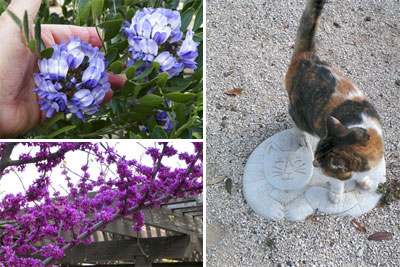
Top left photo: Texas mountain laurel flaunts her flowers. Bottom left photo: ‘Oklahoma’ redbud in its springtime glory. Right photo: Kitty cat magic.
Half an hour later, I am walking through the garden of Master Gardener Joyce Jay. Married for 62 years and gardening for longer, Joyce has created a community of plants, paths, and passion that reflects her spirit better than a mirror. Relaxed and romantic, this garden warms me with its sense of balance and patience. It also comforts the practical side of me, because every plant on this palette is Texas tough, and reflects the best of the Lone Star State. From the Hill Country, Texas mountain laurel (Sophora secundiflora) fills the air with its grape soda fragrance, billowing from sumptuous purple blossoms. From southeast Texas, a trio of yaupon hollies (Ilex vomitoria) still hold a barrage of bright red berries aloft on sculptured branches. Texas redbuds (Cercis texana ‘Oklahoma’) joyously announce early spring with their rosy-purple, and delightfully edible, clusters of flowers strung along zig-zagging twigs. A few precocious inflorescences peek from the red yuccas (Hesperaloe parviflora) strategically placed throughout the garden, hinting of the floral parade that will soon arrive. Underfoot around the edges of the driveway, frothy foliage of erratic patches of Dahlberg daisy (Thymophylla tenuiloba) will soon alight into a fourteen-fortnight, foot-tall festival of cheery yellow flowers. Joyce walks through her garden with a seasoned ease and grace that speaks of true harmony. This garden didn’t happen overnight, and it didn’t happen by accident. It took a good heart, some hard-workin’ hands, a bucketful of gumption, and the spirit to see it through. Hmmm … maybe that’s the secret to, well, just about anything in life.
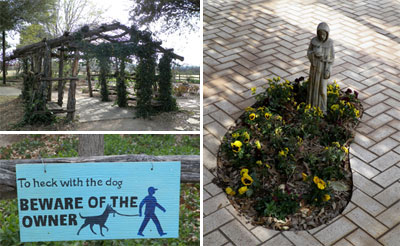
Top left photo: The arbor in Joyce Jay’s garden. Bottom left photo: A touch of whimsy in the Jay garden. Right photo: Stylish inlaid flowerbeds on the porch.
About the author: Steven Chamblee is the chief horticulturist for Chandor Gardens in Weatherford and a regular contributor to Neil Sperry’s GARDENS magazine and e-gardens newsletter. Steven adds these notes:
Spring is blooming at Chandor Gardens! Buds are popping everywhere. You’re welcome anytime, but our Spring Fling festival is extra special. Artists, musicians, craftsmen, and gardeners all work together to make this event an amazing experience … and we do it just for you! Saturday and Sunday, April 6 – 7. Go to www.chandorgardens.com for details. Just take I-20 west to exit 409, hang a right, go 2.1 miles and hang a left on Lee Avenue. Head straight 12 blocks and you’re driving in the gates. Call 817-361-1700 for more information.
I can always use another road trip! Let me know if you’d like me to come out and speak to your group sometime. I’m low-maintenance, flexible, and you know I like to go just about anywhere. No city too big; no town too small. Just send me an e-mail at schamblee@weatherfordtx.gov and we’ll work something out.
